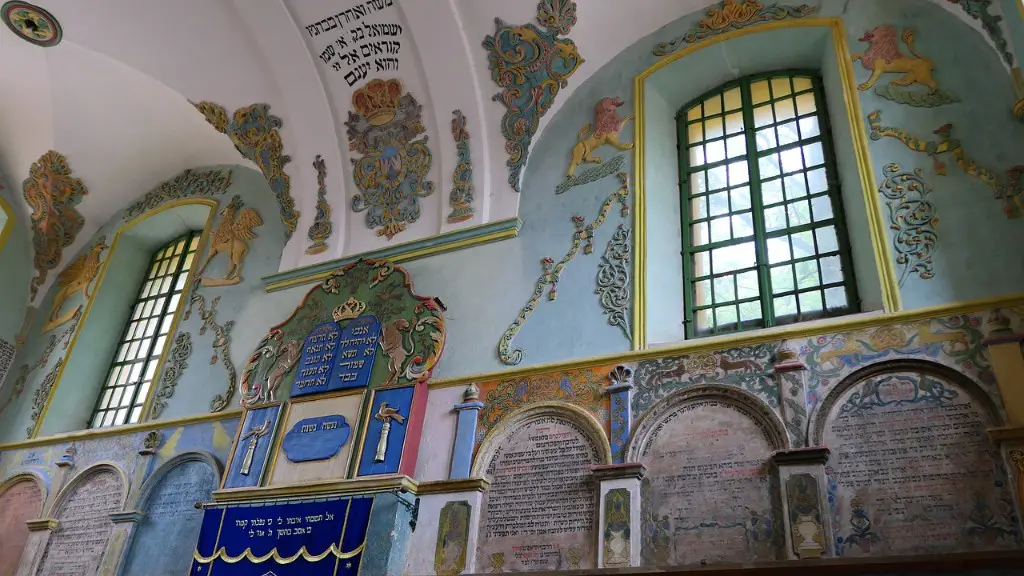1. History & Origin Of Passover
Passover is a Jewish holy day, celebrated annually in the spring. It commemorates the liberation of the Israelites from slavery in ancient Egypt. The story of the liberation is described in the Torah, Judaism’s primary religious text. In honor of the deliverance, the day is called “Passover,” reflecting the Jews’ passing through the angel of death that killed the Egyptians’ first-born sons during the final night of slavery.
The name “Passover” comes from the Biblical account of how the angel of death passed over the homes of the Jews during that fateful night. The Hebrew term “Pesach” (which means “passed over”) is used in the Torah to refer to this holiday.
Passover is celebrated for eight days in both Israel and the Diaspora, beginning on the 15th day of the Hebrew month of Nisan. During this time, celebrants observe dietary restrictions and ritual practices that remind them of their ancestors’ liberation from slavery in Egypt.
2. Significance Of Passover In Judaism
Passover is perhaps the most widely observed and celebrated of all the Jewish holidays. For the Jews, Passover is a reminder of the Exodus from Egypt and the divine intervention that brought about the end of the slavery of the Jewish people. The story of the Exodus holds a special place in the religious consciousness of the Jews, who consider it to be a key part of their religious heritage.
Passover, like other Jewish holidays, is an opportunity for Jews to come together to celebrate their history and faith. Families gather during this time to share their customs and practice religious rituals, such as eating a special dinner, known as a seder, and reciting blessings over the traditional food and drink. The rituals are accompanied by songs, games, and stories that highlight the meaning of the holiday.
Passover is also a time to reflect on the present and the future. Jewish communities around the world use this holiday to think about their lives and the lives of their families, friends, and neighbors. By practicing and understanding the story of the Exodus and its meanings, Jews are reminded of their shared journey and inspired to remain loyal to their faith and traditions.
3. The Four Questions
At the Passover seder, one of the most important parts of the evening is the Four Questions. This is a series of questions posed by a child about the meaning of the Passover holiday. The questions signify a search for understanding and a reminder of the Jews’ affliction in Egypt. The four questions are:
How is this night different from all other nights?
What is the meaning of the green vegetable (karpas)?
Why do we eat matzah, the unleavened bread?
Why do we eat the bitter herbs (maror)?
The questions are followed by the story of the Exodus, which is read aloud at the seder.
4. Grave To Celebrating Passover
The Passover seder is traditionally held in each family’s house, as it is a time for family reunion, bonding and celebration. Because Passover is a time of joy, celebration and freedom, some Jews also celebrate it with going out and attending special events held for this purpose.
In modern times, a variety of ritual items have been developed to enhance the celebration of the holiday. These include special plates, cups, and utensils for serving the traditional foods, as well as a game board and pieces used for re-enacting the story of the Exodus.
In addition to traditional Passover celebrations, there are also more modern ones. In some communities, Jews celebrate with live music and entertainment, as well as with interactive Passover-themed activities.
5. Symbols Of Passover
The most important symbols associated with Passover are the seder plate and matzah. The seder plate is a place setting with six symbolic food items on a plate, including haroset (a sweet, nutty fruit paste), matzah (unleavened bread), maror (bitter herbs), charoset (a sweet sauce made from apples, cinnamon and nuts), and karpas (a green vegetable usually potato or celery).
Matzah is an unleavened bread that is served throughout the duration of the holiday, while the bitter herbs are a symbolic reminder of the slavery of the Jewish people in Egypt. The food items on the seder plate are meant to remind Jews of the hardships their ancestors endured during the Exodus, and to give thanks to God for their deliverance.
Other symbols associated with Passover include the shank bone, a roasted lamb or goat bone that is placed on the seder plate, and the orange, which is placed on the seder plate during Reform seder. In recent years, some have also taken to adding a new symbol to the seder plate, such as a peeled boiled egg, to represent the unfinished work of redeeming the world.
6. The Exodus Story
The Exodus story is the story of the Israelites’ liberation from slavery in Egypt, as described in the Torah. The Israelites were enslaved in Egypt for 400 years before Moses was called by God to lead them to freedom.
Moses led the Israelites to the edge of the Red Sea, where Pharaoh and his soldiers pursued them. Just when it seemed all was lost, God parted the Red Sea and enabled the Israelites to cross over to freedom. When Pharaoh and his army finally followed behind, the water engulfed them, allowing the Jews to safely reach the other side.
The story of the Exodus is celebrated not only as a part of Passover, but throughout the year during the Shavuot festival. This is a reminder of the covenant between God and the Jews, and how they were liberated from slavery.
7. The Haggadah
The Haggadah is a book that contains a script for the Passover seder and is read aloud at the seder table. The book contains the stories of the Exodus, rules for keeping and conducting the seder, and psalms and hymns that are sung during the seder.
The word Haggadah is derived from the Hebrew word for “tell,” and is used to refer to the act of telling the story of the Exodus. The Haggadah is a compilation of various sources, including the Torah, Talmud and Midrash.
8. Freedom & The Passover Message
The message of Passover is that freedom from oppression is possible, and that all people are capable of transformation and liberation. Through the example of Passover, the Jewish people are reminded of the importance of perseverance and resilience.
The celebration of Passover serves as a reminder that we should strive to create a better world, a world without oppression and slavery. It is a reminder of the importance of fighting for justice and equal rights for all people.
9. Passover & The Fight Against Oppression
The story of the Passover serves as a reminder that oppression can be overcome and that freedom is a fundamental right of all people. By understanding the struggles of the Jewish people in Egypt, the Passover story can inspire people today to stand up for those who lack freedom and justice.
In today’s world, it is more important than ever for individuals to fight for justice and peace for all. The Passover story is a reminder that each of us has a moral responsibility to fight for freedom and justice for those who are persecuted, oppressed, or marginalized.
10. Passover & The Jewish Identity
The story of Passover illustrates both the importance of tradition in Jewish identity, as well as the value of adapting new traditions. By understanding the symbolism and rituals of Passover, Jews can gain a deeper appreciation and understanding of their history and culture.
Passover is also a reminder of the unique identity that the Jews share as a people. As a religious and cultural group, the Jews have endured persecution and suffering, but they are also blessed with strength and hope. Passover is a reminder that the Jews can take pride in their unique identity, and that by coming together to observe the holy days, they can continue to pass down their traditions and values to future generations.
Extended Section 1: How Is Passover Celebrated Worldwide?
Passover is celebrated around the world with various customs and rituals. In Israel, where the majority of the population follows the Jewish faith, Passover is one of the most important holidays. Israelis observe the traditional dietary laws and refrain from eating bread, cakes and other forms of leavened grain products. In addition, during the week of Passover, many Jews take part in synagogue services, go on field trips with family, and visit family and friends.
In the United States, Passover is also celebrated, with many Jews observing the dietary restrictions and celebrating the seder, the ritual dinner that marks the beginning of the holiday. In addition, there are many Passover celebrations for the Jewish community, such as services, study sessions, parties, and family gatherings.
In other countries, Passover is also observed, with different customs and rituals depending on the local culture. For example, in some parts of Europe, Jews decorate homes with spring flowers. In India, Jews have their own small shrines outside their homes that are decorated with flowers, candles, and branches. Additionally, in some countries, Jews prepare dishes with local ingredients for the Passover seder.
Extended Section 2: Passover And Jewish Immigration
Jews have been migrating to different countries over the centuries, and wherever they have gone they have taken their culture with them. The Passover holiday, and the story of the Exodus, has been an integral part of Jewish culture and has been celebrated wherever Jews have established a presence.
The Passover story has helped immigrants find a sense of home in their new countries and a connection with their past. In new countries, Jews have used their cultural knowledge and traditions to help build strong communities and keep their heritage alive.
In addition, Passover provides a chance for immigrants to reflect on the values and experiences of their ancestors, and to remember the struggles and hardships of their history. It is a reminder that freedom and justice are not always easily achieved, and that hard work and dedication are required for personal and collective liberation.
Extended Section 3: Environmental Significance of Passover
Today, some Jewish communities are beginning to explore the environmental significance of Passover, and how the traditional rituals can be applied to our current environmental challenges. Passover reminds us of the importance of stewardship of our planet, and the need to use resources wisely.
The ritual of avoiding leavened bread can be connected to the need to reduce our reliance on processed and manufactured foods, and to embrace a more natural and sustainable diet. In addition, the reminder in the Haggadah that water is a symbol of life can be used to promote awareness of our water resources and their importance in sustaining life.
The Passover story can also be interpreted as a call to action to work for justice and liberation. We can reflect on the story of the Exodus, and how its heroes fought for freedom and justice, and strive to bring those same values to our current environmental challenges.
Extended Section 4: Passover And Social Justice
Passover can have an important role in our thinking

